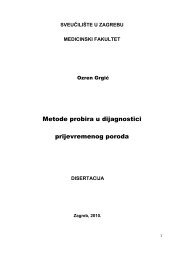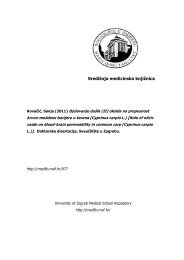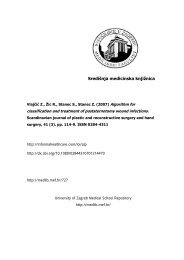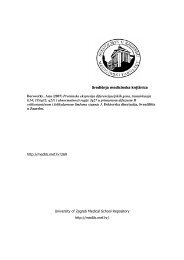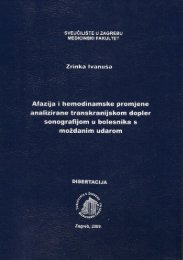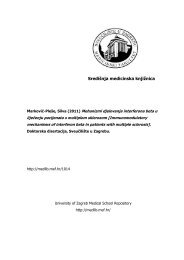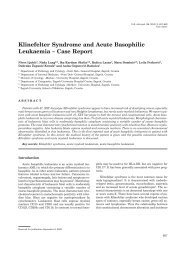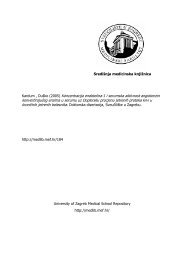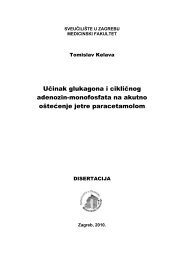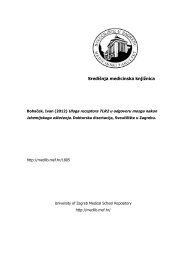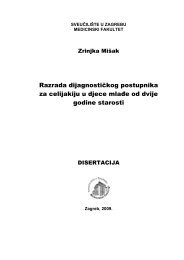Niskodozni protokol CT urografije u obradi bolesnika s ...
Niskodozni protokol CT urografije u obradi bolesnika s ...
Niskodozni protokol CT urografije u obradi bolesnika s ...
Create successful ePaper yourself
Turn your PDF publications into a flip-book with our unique Google optimized e-Paper software.
9. SUMMARYIntroduction: The <strong>CT</strong>U has been proven as a „one stop shop“imaging modality thatoffers the complete analysis of the urinary tract in the course of only one examination. Theshortcomings, when compared to the conventional IVU that was for long time considered a„golden standard” in the evaluation of the patients with hematuria, are the relatively highradiation dose along with its inability to visualize the optimally distended and opacifiedurinary tract in only one scanning phase. In the literature many different patient preparationprotocols have been proposed in order to optimize the distension of the urinary tract but infact none of them has been proven to really work. Introduction of the „split bolus” techniquethat allows synchronous acquisition of nephrographic and excretory phases has led tosignificant reduction in the patient’s radiation dose when compared to the standard threephasicscanning protocol of examination.Aim of the study: To monitor the patient radiation dose during „split bolus“ MS<strong>CT</strong>urography and during conventional IVU. To evaluate the influence of different oral hydrationprotocols (20min versus 60 min prior to examination) in visualization of different urinary tractsegments.Results: Distal ureter: in the group of patients that were orally hydrated with 1L ofwater 1 hour before the MS<strong>CT</strong>U examination the distal ureter was fully visualized in 86.2%,near full visualization (99%-80%) was achieved in 7.4% and visualization of less than 79% ofthe ureter was achieved in 6.3% of patients.In the group of patients that were orally hydrated with 1L of water 20 minutes prior tothe MS<strong>CT</strong>U examination the percentage of fully visualized distal ureters, near fullvisualization (99-80% ) and visualization of less than 79% were 44.4%, 12.7% and 42.6%respectively. In the group of patients that have undergone conventional IVU examination theresults of visualization of distal ureter were as follows:41.6%.12.2% and 45.6%.Proximal ureter: in the group of patients hydrated with 1L of water 60 minutes priorto the <strong>CT</strong> examination the proximal ureter was fully visualized in 91.4%, near fullvisualization was achieved in 4.6% and less then 79% of its course in further 4% of thepatients. The results in the group of patients who received oral hydration 20 minutes prior to<strong>CT</strong> examination were 72.8%, 11.8% and 15% respectively. In the group of patients that haveundergone conventional IVU the results were: 68.4%, 8.6% and 23%.Renal pelvis: in the group of patients hydrated 60 minutes prior to <strong>CT</strong> examination itwas fully shown in 99.45% and less then 79% of it was visualized in 0.5% of the patients.The results in the group of patients who received oral hydration 20 minutes prior to <strong>CT</strong>examination were 90%, 5% and 5% respectively. In the group of patients that have undergoneconventional IVU the results were 95.4%, 4% and 0.5% respectively.Calices: in the group of patients given oral hydration 60 minutes prior to <strong>CT</strong>examination calices were fully visualized in 91%, near full visualization was achieved in4.6% and less then 79% visualization was achieved in 4% of the patients. In the group of85




